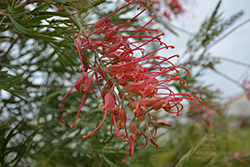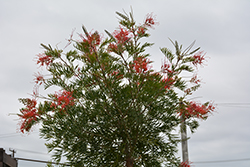It's all about ...
plants

Height: 6 feet
Spread: 8 feet
Sunlight:
![]()
Hardiness Zone: 9a
Other Names: Mason's Hybrid Grevillea
Description:
An adaptable species that develops an upright, dense form; grows well in most well drained soils; apricot-red spidery flower clusters emerge nearly year round and are good for cutting; deeply cut, grayish green ferny foliage adds great texture
Ornamental Features
Ned Kelly Grevillea features showy clusters of salmon spider-like flowers with red overtones at the ends of the branches from late winter to late fall, which emerge from distinctive creamy white flower buds. The flowers are excellent for cutting. It has attractive dark green foliage with grayish green undersides which emerges chartreuse in spring. The deeply cut ferny leaves are highly ornamental and remain dark green throughout the winter.
Landscape Attributes
Ned Kelly Grevillea is an open multi-stemmed evergreen shrub with an upright spreading habit of growth. It lends an extremely fine and delicate texture to the landscape composition which can make it a great accent feature on this basis alone.
This is a relatively low maintenance shrub, and should only be pruned after flowering to avoid removing any of the current season's flowers. It is a good choice for attracting bees, butterflies and hummingbirds to your yard, but is not particularly attractive to deer who tend to leave it alone in favor of tastier treats. It has no significant negative characteristics.
Ned Kelly Grevillea is recommended for the following landscape applications;
- Mass Planting
- Hedges/Screening
- Rock/Alpine Gardens
- General Garden Use
Planting & Growing
Ned Kelly Grevillea will grow to be about 6 feet tall at maturity, with a spread of 8 feet. It has a low canopy, and is suitable for planting under power lines. It grows at a medium rate, and under ideal conditions can be expected to live for approximately 20 years.
This shrub should only be grown in full sunlight. It does best in average to evenly moist conditions, but will not tolerate standing water. This plant should not require much in the way of fertilizing once established, although it may appreciate a shot of general-purpose fertilizer from time to time early in the growing season. It is not particular as to soil type or pH. It is somewhat tolerant of urban pollution. Consider applying a thick mulch around the root zone in winter to protect it in exposed locations or colder microclimates. This particular variety is an interspecific hybrid.
This plant is not reliably hardy in our region, and certain restrictions may apply; contact the store for more information.

